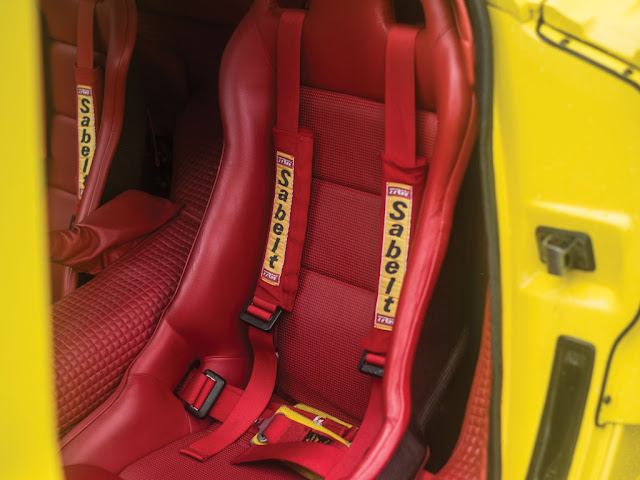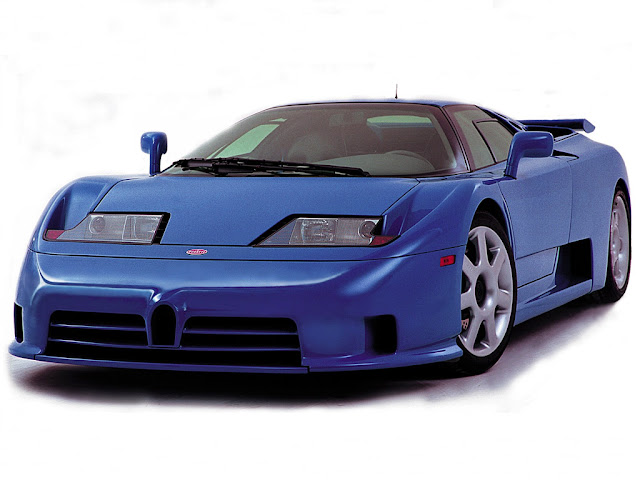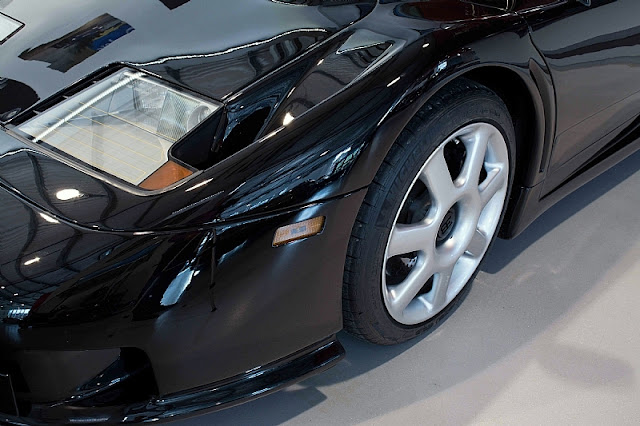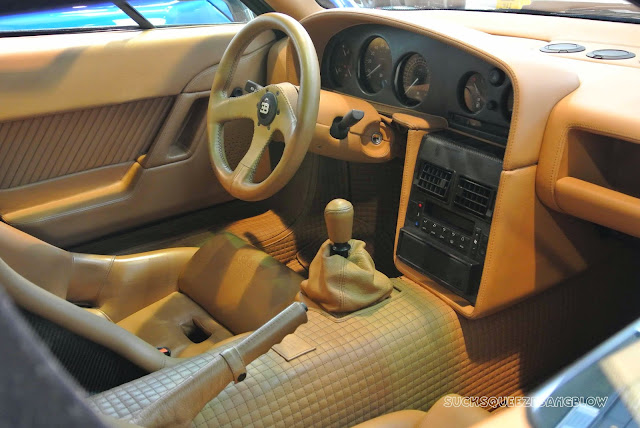The Bugatti EB 110 was a mid-engine sports car produced by Bugatti Automobili S.p.A. from 1991 to 1995, when the company went bankrupt. It was the only production model made by Romano Artioli's Italian incarnation of Bugatti.
The Bugatti EB110 was one of the 90's greatest supercars with an amazing combination of a high technological level (carbon frame, central engine - 560 bhp for the GT, 610 bhp for the SS (Supersport) -, 4 wheel drive and 1550 kg only) and an incredible ease of use. The EB110 became a legend due to its performance, the pedigree of its creators but also for the brevity of its history: from the first car delivered to the bankruptcy, only 3 years have passed.
The Bugatti EB110 was one of the 90's greatest supercars with an amazing combination of a high technological level (carbon frame, central engine - 560 bhp for the GT, 610 bhp for the SS (Supersport) -, 4 wheel drive and 1550 kg only) and an incredible ease of use. The EB110 became a legend due to its performance, the pedigree of its creators but also for the brevity of its history: from the first car delivered to the bankruptcy, only 3 years have passed.
Bugatti EB 110 GT (1991-95)
The original EB 110 GT used a carbon-fibre-reinforced polymer chassis, a 3.5-litre, 5-valve per cylinder, quad-turbocharged 60° V12 engine, a six-speed gearbox, and four-wheel drive. Capable of 560 PS (410 kW; 550 hp) at 8000 rpm. Acceleration to 100 km/h (62 mph) takes 3.2 seconds, and a top speed of 213 mph (343 km/h).
The car uses a double wishbone suspension, with the chassis built by Aérospatiale, an aircraft company, and made from carbon fibre. Equipped with Gandini's trademark scissor doors, it has a glass engine cover that provides a view of the V12 engine along with a speed-sensitive electronic rear wing that can be raised at the flick of a switch.
The EB110 GT is the original and comfort version of the EB110, characterized by a wood dashboard and complete leather interior. The total production number of the EB110 GT seems to be 84 models, including factory cars. (wikipedia & yo.spc.free.fr/EB110_Registry.htm)
Bugatti EB 110 SS (1992-95)
In 1992, a lighter and more powerful model with 612 PS (450 kW; 604 hp) at 8250 rpm, the EB 110 SS (Supersport or Sport Stradale in some Bugatti brochures) was introduced. This car is capable of 216 mph (348 km/h) and 0-100 km/h (62 mph) in 3.2 seconds.
The EB110 SS is the more radical version of the EB110: lightening of the total weight, 610 bhp engine and ultra sporting definition of the chassis and suspensions. Exterior details are specific to the Supersport version: fixed air wing (inclination manually adjustable), 5 lateral air inlet holes instead of the lateral window (one of the first prototypes: Chassis ZA9AB01E0NCD39008 has 7 holes, see photos below), Type 55's style rims, brake cooling aeration located behind front wheels, more aggressive spoiler with an aerodynamic plate at the basis. The interior is lightened too with a simplified transmission tunnel and doors, 2 Recaro seats, manual windows...etc. The production number of the SS is around 30 models. (yo.spc.free.fr/EB110_Registry.htm)
Bugatti EB 110 SS Prototype
1993 Bugatti EB 110 SS Prototype
The EB110 chassis ZA9BB02E0PCD39006 is one of the three prototypes manufactured for the development of the Super Sport version.
1992 Bugatti EB 110 SS Prototype
One of the first GT carbon chassis (C9, ZA9AB01E0NCD39008) is dress with a slightly modified body : the nose is less round (and this design will be applied on next prototypes and GT production models), as well for the side mirrors, the lateral and rear windows are replace respectively by a flat plate with 7 holes and 2 giants Naca air intakes. The back air wing is static, with a dual central pod. The BBS rims are inspired from the famous classic Bugatti ones with 5 spokes. For the first time, a "window in window" system is installed. The interior is consider in a racing spirit also with the suppression of all comfort equipments (electric windows, conditioned air system, Hifi, electric seats...). Two nice bucket seats replaced the GT electric ones, the wood dashboard is now plated with carbon, the glove box is removed and the center console is simplified. (yo.spc.free.fr/EB110_Registry.htm)
Dauer Bugatti EB 110 S (2001-2005)
In 1995, Romano Artioli's Bugatti Automobili SpA went bankrupt and the company was eventually liquidated. During an auction held in 1997, German firm Dauer Racing GmbH purchased seven of the semi-finished cars, fifteen engines, and the rights to the “EB110” name. The company hired ex-Bugatti engineers and technicians and went on to produce nearly a dozen Dauer EB 110 SS cars. which were lighter and produced more horsepower than their Bugatti cousins. Dauer eventually faced their own bankruptcy in 2008.
Dauer first finished uncompleted SS cars still present on the assembly line at the moment of bankruptcy. These "reprocessed" EB110 (EB110 America) are badged with the Bugatti logo and looks like closely to standard models except some details.
Dauer first finished uncompleted SS cars still present on the assembly line at the moment of bankruptcy. These "reprocessed" EB110 (EB110 America) are badged with the Bugatti logo and looks like closely to standard models except some details.
By 2001, Dauer had completed their alterations to the EB110s and offered the five chassis they had finished for sale. The car, named Dauer Bugatti EB 110 S, were fitted with the Dauer logo. They was based on the SS version of the EB110. These cars could be considered like the best and fastest EB110 ever produced, due to numerous modifications and upgrades: 200 kg reduced body weight (full carbon fiber body), tuned engine with 645 bhp (optional 705 bhp with sport exhaust and modified ECU), gas-flow improvement, 322 mm brake discs with four-pot Brembo calipers. Carbon was also used for new one-piece inner fenders and the rear bulkhead. From 0 to 60mph in just 3.3 seconds, blast past the standing kilometer in under 19 seconds and tops out an estimated 230mph, some 12kph faster than the original thanks to lower weight and greater power.
Based on the simpler SS interior, Dauer's EB110's all came equipped with the SS bucket seats, three-spoke steering wheel, transmission tunnel and dash without glove box. Quilted leather covered the sills, transmission tunnel and even the floor, color-matching hide also being used for the dash, instrument binnacle, steering wheel, gearshift, windscreen pillars and door trim. The cockpit was much better finished than before and all five cars came with a combined Kenwood satellite navigation, DVD and TV system. A lot of new equipments may vary from one model to another: GPS aerial, chromed rims, front licence plate support, 4 pipes exhaust system, reversing radar... etc.
(supercars.net, yo.spc.free.fr/EB110_Registry.htm & sometimes-interesting.com)
This special Dauer EB110 S was one of the two first produced and it has the distinction of having a lacquered carbon body. The weight is lightened (1690 kg only, in comparison to the 1920 kg of the Dauer EB110 America) by the extensive use of carbon, many details and components are improved to increase the performance of the car. Major changes are the replacement of the aluminium and steel body by a carbon fiber one and the engine upgrades (645 bhp at 8250 rpm, turbo settings modifications for erase the turbo lag). With the special exhaust system, the power can raise 705 bhp. Performance level of the Dauer EB110 S is astonishing : - 0 to 96.56 km/h : 3.3 s - 1000 m from stop : 19 s - top speed 370 km/h The first car is unpainted with a lacquer covering on the carbon skin. The interior is a SS one but fully dressed with tan leather, with a Kenwood navigation system (DVD + TV player). (yo.spc.free.fr/EB110_Registry.htm)
(Photos from rmsotheby.com, ultimarecarpage.com, ruotevecchie.org,
sucksqueezebangblow.co, joemacari.com, kidston.com & en.wheelsage.org)








































































































































































































































